Previously, we wrote about ‘how to plan and prepare for your next team meeting’ where we outlined post-pandemic meeting formats, and how this shift has affected leadership team meetings and their outcome.
That article was followed by ‘How to Create Purposeful, Intentional Space for Effective Team Collaboration’ where Hybrid Meetings took the stage where we shared tips for team leads on how to encourage participation in their leadership team meeting! This article was written for those leaders who expressed difficulty getting team members to actively participate in a team meeting.
In this article, we will step into the final phase of learning more about leading team meetings which is ‘how to have true dialogue’.
Before you read on, let’s talk ‘GroundHog Day’ conversations first.
“Groundhog Day conversations are those conversations we are having, over and over without resolution.”
What patterns might this type of conversation be falling into? How can you change the nature of the conversation by bringing in a different vocal act?”
Let’s find out together!
Read the Room, Change the Outcome
There are four kinds of conversational action in all of our communication.
Every sentence or phrase we say can be coded into one of these four actions that David Kantor calls “speech acts”:
- Move
- Follow
- Oppose
- Bystand
To be in an effective and productive conversation, we need all four of these to be active and valued in the conversation. A high functioning team dialogues when all four of these are active and individuals are fluid in their ability to voice all of the actions.
When one or more of these are missing, teams can get stuck and end up in ineffective conversations that are not collaborative. The result is that Groundhog Moment.
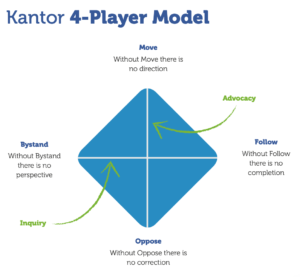
Common Stuck Patterns to Looks for in Team Meetings
The task of a leader or facilitator is to help a team or group notice its own pattern of interaction using the four action propensities. The next step is to help them change the nature of their discourse, particularly when they get stuck in certain patterns.
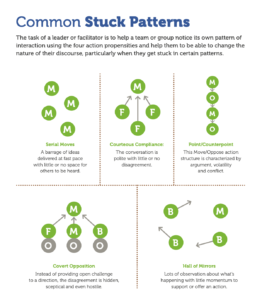
Fields of Conversation That Groups Experience
The types of conversation that groups experience as they move towards more complex and effective patterns of conversation.
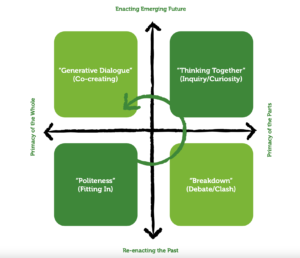
Ways to Prompt a Group Towards a Specific Action
Facilitators or leaders can pose questions to the group to help prompt a certain action.

FOLLOW
- Who agrees?
- What do you appreciate about this?
MOVE
- What would you add?
- What else might be needed?
OPPOSE
- Who sees it differently?
- What’s at risk here?
BYSTAND
- Where is the group at right now?
- What are you noticing?
- What is your experience right now?
How To Get Started Reading the Room
- What are the actions you’re hearing
- What’s the pattern that’s showing up?
- What action is missing? How can you prompt the group for a new action?
What are the actions you’re hearing?
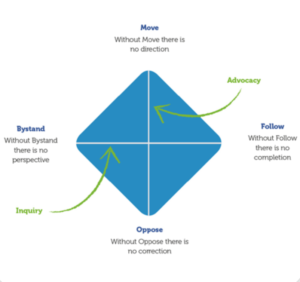
What’s the pattern that’s showing up?
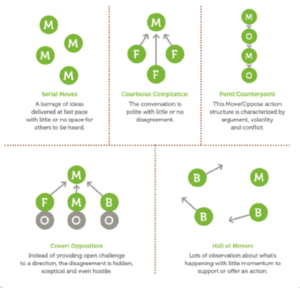
What action is missing? How can you prompt the group for a new action?
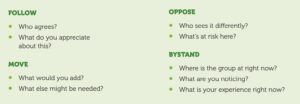
Still Stuck? Check and Read These 4 Resources Next!
- Diagnosing and Changing Stuck Patterns in Teams
- How Daring to Dialogue Creates a Culture of Agility in Leadership
- The Most Effective Approach of Continued Dialogue: It’s Where Change Happens!
- How Do Conversations Work? The First Steps to Effective Dialogue
How to lead a meeting effectively
Leading effective team meetings are essential for achieving success in any organization and a huge part of being effective is overall meeting participation.
By using different leadership team meeting formats and models, such as the David Kantor 4 Player Model of Communication, leaders can reignite team meetings and create a more productive and engaged team environment and encourage active participation.
Having a clear meeting agenda and taking accurate meeting notes are also important for keeping everyone on the same page and ensuring that other team members are accountable for their contributions.
Remember to actively engage team members in the meeting, allowing everyone to share their thoughts and ideas.
Finally, set goals and follow-up on the action items discussed in the leadership meeting, making sure everyone is on the same page and ready for the next meeting. With these tips, your team meetings will become more productive and successful, and your conference room will be a space where ideas are shared, progress is made, and everyone feels empowered to contribute.